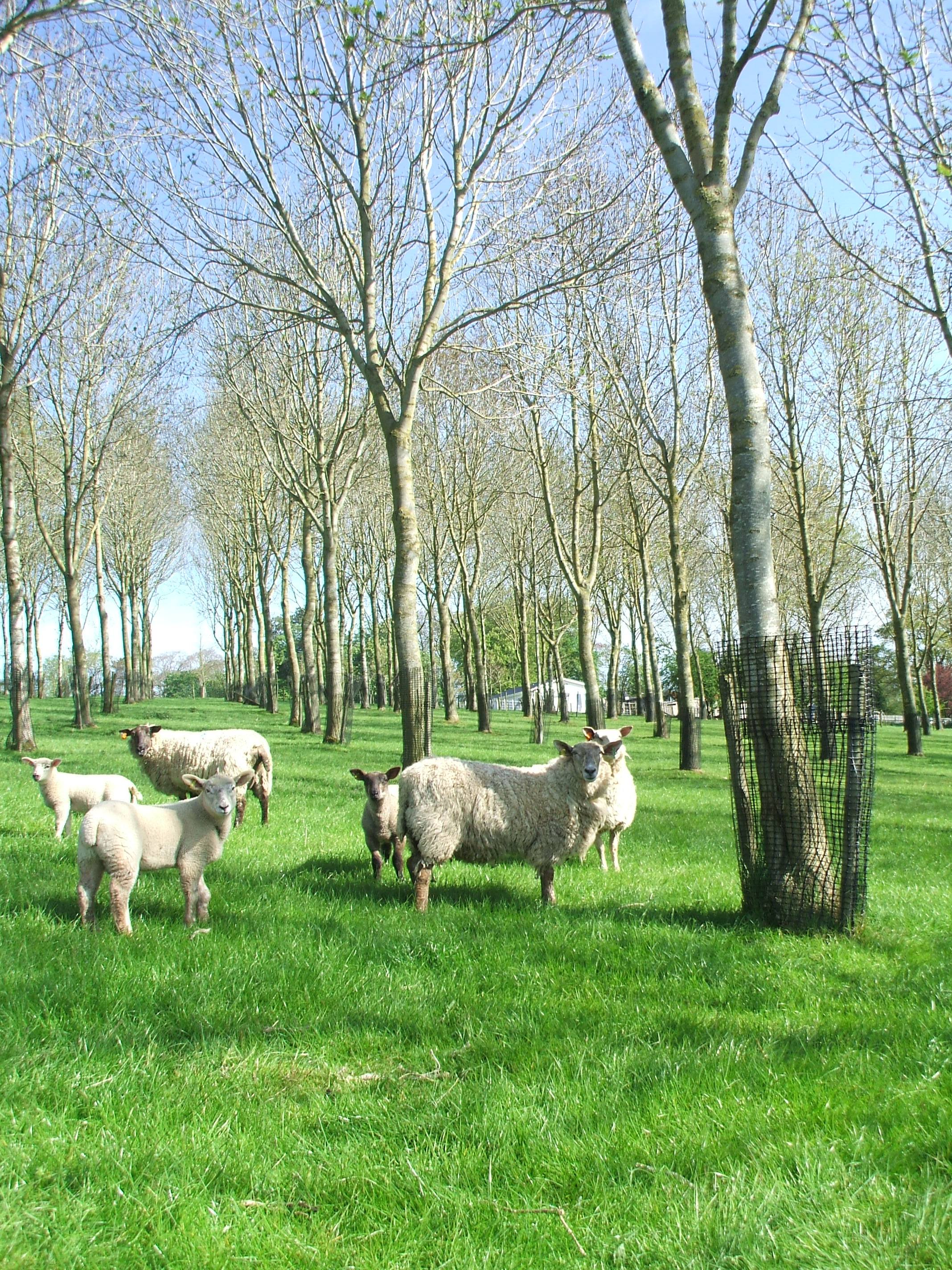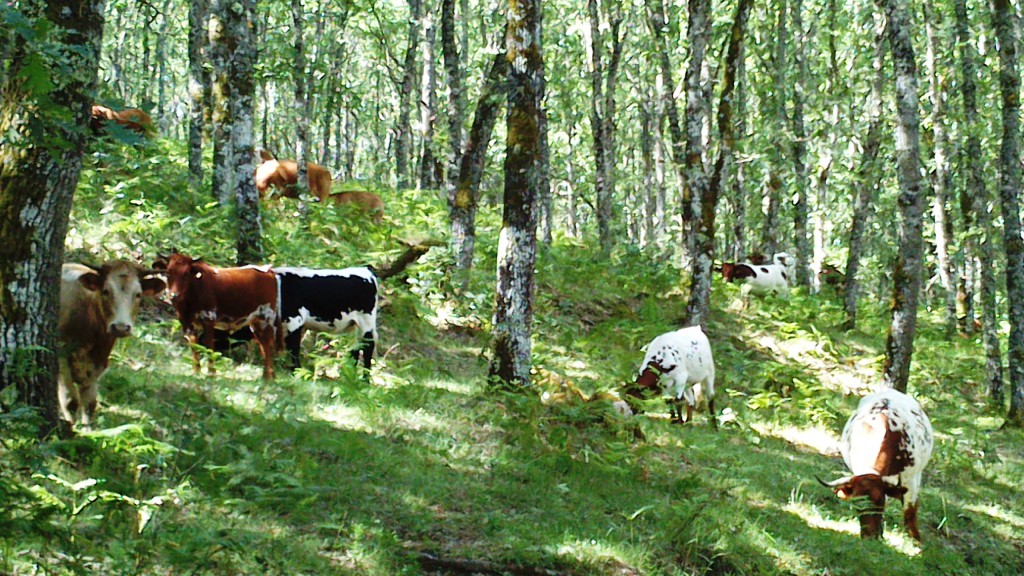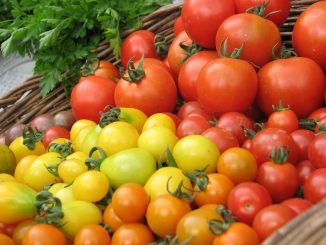This long read by Claire Kremen, considers the issue of “land sparing vs land sharing”. This is a hot topic in the conservation world, paralleling to an extent the intensification vs organic debate in the farming community. Kremen poses the familiar refrain – should we be as productive (in terms of yield) as possible, thus leaving more land for nature, or should we try to get farming and nature to work better together? Kremen critiques this debate as overly simplified and suggests more efficient consumption patterns – described as stabilising the agricultural land footprint – along with creating a favorable agricultural matrix in particular by incorporating (and better supporting research into) agroecological methods.
By Claire Kremen

As it is practiced today, agriculture is one of the biggest environmental offenders – yet it is necessary for our survival. Agriculture contributes one-third of greenhouse gas emissions, uses 70% of freshwater resources, and harms wildlife through conversion and fragmentation of biodiversity-rich habitats, water diversions, pesticide poisoning and creation of oceanic dead zones.1–3 And, as the human population grows and becomes more affluent, demand for food production is increasing, especially for luxury products that are more environmentally demanding.4 How can we balance demand for agricultural products with biodiversity protection?
This question has prompted the land-sparing land-sharing debate.5–7 Land-sparing advocates argue that intensifying agriculture to produce higher yields is a necessary first condition to allow agriculture to contract to a smaller land footprint, providing opportunities for “sparing land for nature.” They have further shown through a series of papers that most tropical forest species that have been studied (i.e. primarily birds and plants) cannot tolerate agriculture and will fare better under a land-sparing scenario that protects large land-areas.8–10 In response, land-sharing advocates point out that ‘wildlife-friendly agriculture’ need not be low-yielding (as is generally assumed by land-sparers) and that intensive agriculture often has negative environmental consequences that spill-over into surrounding natural habitats.11 In addition, they note that many species utilize matrix habitats,12 and many rare, threatened or endangered species now rely on agriculture to maintain their habitats, usually open or early successional habitats.13
The debate has been heated. I and others have questioned the utility of this debate.14 Does the debate help to set research, action or policy directions in conservation and land use? Or does it simply divert our attention from more challenging but more realistic and robust ways to reconcile human needs with biodiversity conservation?
Land-sparing vs Land-sharing: An Over-simplified Debate
The fallacy of the land-sparing land-sharing debate is its seductive simplicity.14 The debate centers on the assumption that there is a fixed target of production that must be met, either by high-yielding agriculture on a smaller land area, or low-yielding agriculture on a larger land area.15 Norman Borlaug, the architect of the Green Revolution and originator of the land-sparing concept, thought that as agriculture became more efficient and higher-yielding, prices would fall, forcing less productive farmers out and reducing the overall land area devoted to agriculture. However, empirical data does not support this claim. Forest economist Rudel, in his 2005 analysis of 10 major commodity crops in 161 countries, found that “the most common pattern involved simultaneous increases in agricultural yields and cultivated areas” (emphasis added).
This simultaneous increase is an example of a “Jevons paradox” – as prices fall due to increased or more efficient production, demand also expands.16 Global supply chains can readily soak up the surplus supply, profiting from cheaply produced commodities like palm oil or corn, for example, to fabricate hundreds of profitable products. Thus, whenever increased agricultural productivity spikes new demand, yield increases will not lead to land-sparing,17 unless accompanied by strong market-based and/or regulatory environmental safeguards that stringently restrict agricultural expansion into primary habitats.18–20 For example, in Peru, where the government encouraged investment in oil palm agriculture, researchers found that highly-capitalized, intensive growers used less land than small to mid-sized producers that had lower-yielding operations. However, this example of land-sparing did not lead to nature-sparing, since the highly-capitalized growers disproportionately cleared primary forest sites for their operations.21
Although proponents of land-sparing—land-sharing framework have now recognized that “the land sharing-sparing framework does not tell us that high-yield farming will result in land being spared for nature: it is an analytical framework for understanding the “biophysical option space,” that distinction will not prevent corporate agribusinesses from using the logic of land-sparing to promote their own agendas. That logic is: ‘Biodiversity fares poorly in agriculture, therefore we must make agriculture as high-yielding as possible, to spare land for nature.’
That logic fuels the claims of agribusiness companies that they are both helping to protect biodiversity and ‘feeding the world’ by improving crop yields. In fact, their goal is to make profits, and while a variety of companies are taking important steps to mitigate damages along their supply chains,22 agribusinesses produce and market many inputs like pesticides that hurt wildlife, and contribute to tropical deforestation through ‘land grabs’ that convert forested lands to intensive agriculture.23 On “feeding the world”, large-scale industrialized agriculture does not produce the lion’s share of global food (only 23 – 49%),24 and a significant fraction of what it does produce is then lost in the conversion of grains (which make up much of industrial agricultural production) to meat.25
Finally, agribusinesses sell products that often do not provide the yield benefits they claim, meaning that, paradoxically, ‘high-yielding agriculture’ isn’t actually always high-yielding. Because agribusinessess are so concentrated (for example, only 3 companies globally control 50% of agrochemical inputs, while 10 companies worldwide provide the majority of foods and beverages), they can greatly influence how farmers actually farm and resulting land use patterns over very large land areas – certainly relevant to biodiversity conservation. For example, in the United States, most corn and soy farmers plant seed treated with neonicotinoids, a pesticide that harms pollinators26,27 and other wildlife,28 simply because the majority of the available seed supply is treated. Agribusinesses that supply the seeds are profiting by selling the more expensive, treated seeds, which don’t even provide a yield benefits for farmers!29,30 This practice affects > 57% of the US agricultural area ( > 42 million ha),31 showing the enormous impact that the search for corporate profits can have on biodiversity and the environment under the guise of what is essentially a land-sparing argument.
How to Stabilize the Agricultural Land Footprint
The most immediate way to prevent further agricultural expansion into natural habitats is to have strong environmental policies and governance that prevents the expansion. Over the longer term, however, we can prevent further agricultural expansion by reducing consumption, and its companions, waste and inequity.32 Such solutions are not politically popular because they push back against the growth economy; yet there are three obvious places to start that could yield huge dividends for biodiversity and for current and future quality of life.
First, we could reduce meat consumption and the large land area that is devoted to producing it. Currently livestock production occupies 1/3 of the terrestrial ice-free land surface, and consumes grains from 75% of croplands.33 Feed crops constitute 36% and 53%, respectively, of the calories and proteins in global crop production: yet only ~4% and ~26% of these crop-based calories and protein return to human diets, due to vast conversion inefficiencies as nutrients move up the food chain.25
Reducing meat consumption by half could feed 2 billion people, reducing the burden of hunger on the planet without increasing the area under cultivation at all. As economies develop, however, they are clamoring for more meat, not less.33 In fact, this rising demand constitutes a large component of the oft-repeated claim that food demands will double by 2050.4 Food demands are not the same as food needs,34 however, and, eating too much meat is a well-recognized contributor to heart disease, stroke, type 2 diabetes, obesity and certain cancers.35,36 Reducing meat consumption by those who eat too much, stabilizing it at current levels for those who are eating the right amount (about the size of a pack of cards per capita per day),33 and increasing access to meat for the 2 billion people who suffer from iron-deficient anemia,37 could help to solve several global disease crises at once. Finally, re-integrating livestock into smallholder farms could help to reduce nutrient overloads produced at contained animal feeding operations, reduce the overuse of antibiotics in livestock, and return critical nutrients to the soil and to the diets of small-holder or subsistence farmers.33
Second, we could reduce the current wastage of 30 – 50% of the food that is produced annually.38 Instead of worrying about whether organic agriculture produces only 80 to 85% of the food produced by conventional agriculture,39 why not cut the wastage by half? That would take care of the organic to conventional yield gap without requiring more land, while improving conditions for biodiversity on farms40 and growing food in a more sustainable manner.41 Further, preventing food waste would also prevent wastage of all the energy, water, inputs and labor that went into producing it. Some of these inputs, such as fertilizers and pesticides, are exerting damaging effects on our oceans and streams, our wildlife, and human health.1
Third, the growing human population also increases consumption — but we could stabilize human populations at lower levels than currently projected by meeting the unmet need for family planning.42,43 Many families wish to reduce the number of births, but do not have the means to do so. If these unmet needs for limiting reproduction could be met, human population could potentially stabilize at 6 – 7 billion people instead of the 9 – 13 billion people currently projected for 2100.44,45
A number of countries, including impoverished countries like Bangladesh, have made huge strides in providing contraception to families that desire it, halving total fertility rates in two decades or less.43 Meeting these needs through voluntary family planning can simultaneously improve child and maternal health and reduce poverty.43 We produce enough food annually to feed today’s population of 7.5 billion with our current agricultural footprint, although many people remain hungry or malnourished due to poverty and lack of access to sufficient, nutritious food.34 Thus, policies that support the universal access to reproductive health and family planning services (e.g. Millenium Development Goal 5b) should be a top priority not only for human development43 but also for biodiversity and environmental conservation.
Farming for the Future

Any agricultural use will markedly change biodiversity in a region, and often impoverish it;46,47 thus, stabilizing the agricultural footprint is the critical first step for biodiversity conservation (i.e. no more expansion, particularly into primary habitats that are rich in biodiversity).1,33 Assuming that we could stabilize the existing agricultural land footprint primarily by reducing consumption (as described above) and creating strong environmental policies and governance that ensure nature protection, how should we farm in a manner most compatible with biodiversity conservation? I believe there are four main components needed:
- Create a favorable agricultural matrix that promotes wildlife dispersal between protected areas to reduce long-term negative effects of isolation, such as inbreeding and extinction debt, which ultimately will affect even very large protected areas.48 Developing a favorable agricultural matrix could be accomplished by strategically restoring or protecting corridors of native vegetation surrounded by or interlocked with the most hospitable types of agricultural habitats, such as agroforestry,49 silvopastoral50 or other diversified agroecological systems,51 as has been proposed for the Mesoamerican Biological Corridor.52
- Use agroecological methods in the agricultural matrix that rely on the underlying biodiversity and ecosystem services, and that reduce negative impacts of agriculture on adjacent habitats and downstream regions.41,51,53,54 Primarily this involves reducing pollutants like pesticides and excess fertilizer that can kill wildlife or cause dead zones in lakes and oceans. For example, intercropping and crop-rotation reduce the concentration of a given crop in space and over time and thus the crop’s attractiveness to pests. In turn, areas of plants that support beneficial insects, polycultures and hedgerows provide habitat and resources for natural enemies of crop pests. These techniques can greatly reduce the need for pesticides,55–60 which are sometimes over-used and therefore add costs to farm budgets without improving yields.30,61,62
- Maintain productive, sustainable agriculture that supports livelihoods of local people living in the vicinities of protected areas. Agro-ecological methods, such as agroforestry, integrated pest management, and livestock integration, can substantially increase yields for people formerly practicing either conventional or subsistence agriculture, across the board for a wide variety of crops.58,63,64 Further, there is strong evidence that increasing plant diversity in crop, forage and forestry systems increases yields,65 and, that when yield gaps occur, they can be minimized or eliminated by agroecological methods that diversify the system, such as intercropping, cover-cropping and crop rotations.56,66–68,59 In some systems, removing land from production to create wildlife habitat has been shown to benefit production by increasing ecosystem services like pest control or pollination.50,69,70 Finally, compared to monoculture systems, these agroecological methods increase resilience to drought, pests, diseases, floods, hurricanes and climate change,51,71–73 and help to preserve the sustainability of the system, by maintaining soil organic matter, water infiltration and holding-capacity, pest and disease control, pollination services, etc.41
- Invest in agroecological and agronomic research and development to improve yields in diversified systems (with low reliance on external chemical inputs) in different cropping systems and regions. While there is compelling evidence that diversified, agroecological farming systems can be high-yielding,65,74 there are still few data available that comprehensively assess the productivity and profitability of highly diversified production systems against monoculture agriculture. Further, there has been far less research and development oriented towards enhancing yields and agronomic techniques used in such systems, compared to conventional or industrialized agriculture,64,75 including breeding crops that yield well in diversified, low-input conditions.65,76,77
Final Considerations

The land-sparing land-sharing debate raises an important issue for conservation about how to best reconcile agriculture with biodiversity conservation and what are the tradeoffs for different types of farming systems. However, the debate does not help to identify the actions that need to be taken to protect biodiversity, because this debate cannot help to predict large-scale outcomes of farming decisions, which, are made by multiple actors that respond not only to government policies in their own countries, but also to the forces of trade and globalization, including the actions of a small number of powerful, global corporations. Conservationists should instead focus on other research questions and actions that will affect biodiversity conservation more directly.
Research. There is an urgent need to understand how different types of agriculture, as well as other matrix types,78 affect the dispersal capacities of wildlife. Very little information exists, for example, on how various mammal species travel through row-crop monocultures versus agroforests and silvo-pastures. Such information would assist in determining how to manage agricultural landscapes to promote dispersal and reduce the extinction debt that faces even large protected regions.48 It is also urgent to understand how specific farm management practices affect species of concern, and whether practices can be adapted to favor either use of agricultural habitats, or movement through them, without negative effects on yields or livelihoods.79,80 Similarly, it is critical to determine which agricultural methods create the fewest negative spillover effects into adjacent natural habitats. Finally, incorporating socio-economic studies and participatory research can aid in focusing research questions on outcomes that can help inform pragmatic strategies appropriate to the conservation and agriculture needs of a given region.14,52 These types of studies, and others,14 would help to guide specific conservation actions to reconcile biodiversity conservation with agriculture.
Action. We urgently need to undertake actions that reduce meat consumption and food waste, and that help families who want to control family size to gain access to contraception. These ‘demand-side’ actions will help to reduce the amount of food needed and thus the land-base needed to grow that food, helping to create an ‘option-space’ for more biodiversity conservation. Such actions are not traditionally part of conservation organizations core activities, however. To be effective, they must be joined with traditional conservation activities, such as working with governments to create and manage protected areas, design effective landscapes that balance human and wildlife needs,81 and put in place strong environmental policies and governance systems that protect and restore biodiversity. Finally, conservation organizations should continue to develop innovative programs that can support biodiversity conservation not only in natural areas but in farmlands, such as The Nature Conservancy’s Bird Returns program for migratory birds.
I believe that with this focus, my vision that “most, if not all, conservationists could get behind,” of “large protected areas surrounded by a relatively wildlife-friendly matrix”14 could indeed become a reality.
Thanks to E. Kearney, C. Kennedy and L. Ponisio for comments on versions of this blog.
This article first appeared on the Cool Green Science Blog – the conservation science blog of The Nature Conservancy. This article does not necessarily represent the opinion of ARC2020.






